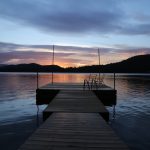On the Trans Canada Trail with Paul LaBarge
It was going to be a bonanza that would make a few adventurous people very rich. It was 1896 and gold had just been discovered in the Klondike. Small settlements quickly ballooned into boom towns as tens of thousands of would-be prospectors flocked to the area in search of adventure and fortune.
Getting to the gold wasn’t easy, though. To get to the Klondike region, stampeders first had navigate harrowing landscapes, hiking up snow-covered mountains and across frigid creeks, burdened further by heavy loads of prospecting gear and survival essentials.
The creation of the Ridge Road in 1899 made things easier. As the first government-built wagon road, it became a major supply route to the goldfields. Shops and services opened up along the road, offering spots where travelers could replenish supplies, find a drink or tell tall tales with other Gold Rush pioneers.
The prosperity didn’t last forever. The Gold Rush was largely over by 1899. The good ground had already been staked and reports of more gold in Alaska had many miners on the move. The Ridge Road was decommissioned in 1902.
It could have just been a dusty story of Canada’s Gold Rush, but today, more than a century later, the route is being retraced by new kinds of prospectors in search of history, adventure and exercise. It’s now called the Ridge Road Heritage Trail, a 27-kilometre long segment of the Trans Canada Trail that runs through Dawson City. Where once, they say, nuggets of gold could be picked off the creek floor, tourists are exploring the area by foot, bike, horseback, ski and snowmobile.
This is the story on trails across Canada: history, nature and culture combine to reveal their intricacies to newer generations of adventurers. Each part of the Trans Canada Trail, a network of trails snaking through all corners of the country, shines a light on a community and the people and history that make it unique. Spanning more than 20,500 kilometres, the Trail goes from province to province, territory to territory and sea to sea to sea.
Wouldn’t it be great
The Trans Canada Trail was born in 1992, the legacy of the Canada 125 celebrations held to commemorate the significant anniversary of Canada’s confederation. The project was spearheaded by three Canada 125 participants: Pierre Camu, Bill Pratt and Paul LaBarge.
LaBarge, who currently serves as Trans Canada Trail Chair, says the origin of the trail was very organic. There was some money – about $900,000 – left out of Canada 125’s $90 million budget so thoughts soon turned to what to do with it. They needed a project that would benefit all Canadians.
“We got talking and Pierre said “Wouldn’t it be great if we had trails across Canada?,” says LaBarge from his office at LaBarge Weinstein LLP, a business law firm he co-founded in 1997.
It was proposed to and approved by the Canada 125 Board as its legacy project.
“That was the beginning,” LaBarge says. “Pierre, Bill and I signed the original incorporation documents and I’ve been involved with it ever since.”
Canada at human speed
Eighty percent of Canadians live within 30 minutes of the Trail. LaBarge says that easy access for most Canadians is important.
“It gets you out of the bubble. We have all of these transportation methods that allow us to go faster,” he says. “But, you go faster: you see less. You go further: you see less. You don’t meet your neighbours. You don’t see and absorb a sunset; you just drive by it.”
The Trail is multi-use and designed for users to explore through a variety of activities including walking, running, hiking, cycling, horseback riding, canoeing and skiing. This different perspective lets Trail users see a different side of their neighbourhoods and their country.
When driving by, “you don’t see the fabric of a town, you don’t get to know anybody. You don’t have that conversation in the diner. You just keep going. You’re a stop on the highway and you have no idea about the fabric of this town: its origins, its history,” LaBarge says.
“When you walk through someplace or you ride through someplace on a bicycle, you start to understand who your neighbours are. As one of our directors Valerie Pringle says: it’s to see Canada at a human speed.”
“It doesn’t cost more than a pair of shoes,” LaBarge adds. “Get off the couch, put on your shoes and get out on the trail. That’s it. Away you go.”
A gift
LaBarge believes that while the Trail itself was created as a legacy of Canada’s 125th anniversary, the new legacy it leaves is just as inspiring.
“I think the Trail is a gift from each Canadian to every other Canadian. What it is is an opportunity for better health. It’s an opportunity for personal development. It’s about education. It’s about environment. It’s about tourism. It’s about ecology.”
Local communities play a significant role in the ownership and maintenance of the Trail. Often, community members will use their part of the Trail as a springboard for education. In some First Nations communities, locals guide tourists through the area.
“The guides will actually explain to you the significance of the plants and the various things you’re seeing, in their cultural context. It’s a cultural exchange and it’s history. Who went through here? How did this town get here? It has so many fibres that it just gives you this texture. To me, it weaves together all of these fibres to create what is our society.”
Tourism dollars
The Trans Canada Trail has also been a boon for some local economies that rely on tourism dollars.
“As an example, when the Premier of P.E.I. opened the finishing of the Trail in the province, he made the comment that already the Trail was the second most popular tourist attraction in PEI right after the house of a person that never lived,” says LaBarge with a nod to Anne of Green Gables. “Think about that.”
As the Trans Canada Trail grows, LaBarge is certain that the people – and the income for local economies – will follow.
“For instance, you consider the development in Fogo, Newfoundland, which everyone has read about. It’s all based on trails in that area,” he says.
“Go to Banff: trails. Go to Whistler: trails. Go to Vancouver: trails. Go to Toronto: waterfront trails. It’s there. It’s everywhere. It’s ubiquitous and it’s so important.”
The personal connection
If LaBarge seems passionate about the Trail and the outdoors, it’s because he is. Growing up in the Ottawa area, he spent much of his childhood summers in Gatineau Park. When he first started his law practice, LaBarge worked on a case that took him to every province and territory in the country.
“I think it was really then that crystalized my enthusiasm for Canada,” he says. “It was so beautiful.”
“I’ve been lucky. I’ve seen more of this country than most people and it’s amazing,” he adds.
“There’s not a part of it that’s not amazing. It’s a different kind of beauty everywhere. I can go to places in Labrador or Newfoundland where all you see are rocks, but if you look down into the rocks you see the heather and you see wild berries and these sprinkles of colour. There’s beauty everywhere you look if you take the time to see it.”
These days, despite running the tax team at a busy business law firm and remaining active with a number of community initiatives, he is still spending his time as he likes to: outside, hiking or on his bike. He likes to travel around the world to hike but still logs the kilometres on the trails near his home.
“For me, the Trail is exercise. If you’re alone, it’s contemplation. If you’re with someone else, it’s a dialogue,” he says.
He’s often out on the Trails alone, getting out at 5:30 in the morning for a bike ride.
“But I still see people,” he adds. “We say hello. You don’t see a lot of grumpy people on trails.”
Next steps on the Trans Canada Trail
As Canada prepares to celebrate the 150th anniversary of Confederation in 2017, the Trans Canada Trail is working towards connecting all parts of the existing trail system. Currently, about 86 percent of the trail is connected.
“When we’re done, we will be The Great Trail,” says LaBarge. “We will be the longest recreational, multi-use trail in the world. It’ll connect 15,000 different communities. That’s pretty awesome but on top of that, the countryside that it goes through – this country of ours – is awesome.”
To get there requires money. The Trans Canada Trail is fundraising to ensure that the Trails will be connected and maintained for future generations of Canadians to enjoy. Donations made by August 31, 2016 will be matched thanks to Trans Canada Trail patron Jack Cockwell and the Government of Canada.
LaBarge believes that connecting the Trans Canada Trail is essential to keep Canadians active.
“If exercise is part of the fabric of your life, you’ll live longer, you’ll live happier and you’ll be a nicer person,” he says.
A photo posted by Trans Canada Trail (@tctrail) on
A photo posted by Trans Canada Trail (@tctrail) on
A photo posted by Trans Canada Trail (@tctrail) on
A photo posted by Trans Canada Trail (@tctrail) on



